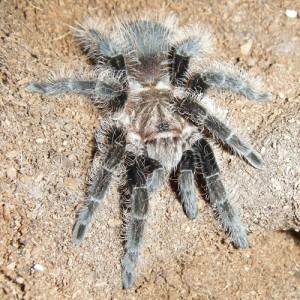Red Slate Ornamental Tarantula (Poecilotheria rufilata)
Old World, Poecilotheria No Comments »The Red Slate Ornamental tarantula is a species from India that spends most of its times up in trees or plants of the Indian forests. It is a very rare species to come across due to the rare breeding of it, spiderslings tend to be very delicate and require a lot of maintenance until reaching full adult size. In addition they are scarce in the wild due to their natural habitat being threatened due to cutting of trees and plants and deforestation in India. They are most definitely a species for the more experienced of hobbyists. They tend to grow between 7 to 9 inches in length and get to be anywhere from 4 to 9 years old.
Habitat:
The Red Slate Ornamental Tarantula is an arboreal species who likes to spend its time up in trees in the wild. You will need an enclosure of about 10 to 15 gallons that is more tall then it has floor space. About 3 inches of substrate should be used. We recommend a coconut fiber and peat moss mixture, make sure it is heavily damp. A nice piece or pieces of bark should be added for your tarantula to climb up on. It will end up webbing its home at the top of your enclosure. A fresh water dish should also be available and always overflowing with clean water. Misting is not needed but you can still do so once or twice a week. Just be sure to not spray directly on top of your tarantula but more towards the panels of the enclosure. You should have a temperature of about 68 to 75 degrees and a humidity level of about 75%.
Feeding:
The Red Slate Ornamental Tarantula is an easy eater and will devour pretty much any insects you can mix up its diet with. You can feed them either crickets, cockroaches, locusts and moths. A feeding of once a week should be just fine. As always should you see that your p. rufilata has not eaten its prey within 24, remove the prey. It could be that it has no appetite or in some cases could be in pre-molt stages. Do not stress out your tarantula by having the prey stay in the enclosure.
Attitude:
These are very skittish animals and can easily get startled. They are quite fast as slings or juveniles and only slow down as they reach adulthood. They do not come with urticating hairs and their primary line of defense is their bite. Though their venom is not lethal it still has a medium toxicity level that can cause moderate pain, muscle cramps and sometimes fever like symptoms. They are not as aggressive as other old world tarantulas but will easily go on the defense should they feel threatened.
We would not recommend this species for a beginner tarantula keeper but for more advanced and experienced hobbyist. It is very rare and great species to have.



